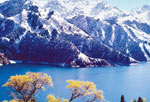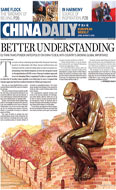Politics
Doctored bin Laden corpse photos go viral, global
Updated: 2011-05-05 10:25
(Agencies)
SAN FRANCISCO - The images are bloody, grotesque and convincing: Osama bin Laden lies dead, the left side of his head blasted away. But the pictures are fakes.
Doctored photos purporting to show bin Laden's corpse rocketed around the world on television, online via social media and in print almost as soon as his death was announced.
| ||||
Newsrooms and the public have been left in the tough spot of deciding what to believe when software has made doctoring photographs easier than ever. And the hunger for visual evidence of bin Laden's death may only grow now that President Barack Obama has said the government's photos will remain classified.
"I don't think society tolerates the invisible anymore," said Fred Ritchin, a professor of photography at New York University who has written about digital technology undermining trust in the veracity of photographs. "Everything has to be imaged."
The photos on the Internet did not come from the operation that killed bin Laden, according to a senior defense official who spoke on condition of anonymity because the mission was classified.
Still, the appetite for images remains. In perhaps the most widely distributed photo, a bloodied bin Laden appears to be missing his left eye, and he is grimacing as if he died in pain. The White House says bin Laden was shot above his left eye.
Reuters reported on its photography blog that the mouth, ear and beard in the picture exactly matched a photo the news agency had snapped of bin Laden at a news conference in 1998. The upper half of the face appears to be from a different corpse.
Another photo released on the website liveleak.com shows bin Laden lying on his back with a wound over one eye as a soldier with an American flag insignia on his shoulder stands over the body. The photo is in green and black, as if taken with a night vision lens.
The website has since retracted the photo, which liveleak.com indicated was made with a photo of bin Laden digitally stitched into a still from the 2001 movie Black Hawk Down.
Another picture, by far the most gruesome, shows an extremely bloody face that resembles bin Laden with most of the skull missing and brain visible.
The spread of fake photos and the ease of making them have forced news organizations to be more vigilant than ever.
"The challenge here is these techniques are quite sophisticated," said Santiago Lyon, director of photography for The Associated Press. "A good Photoshop forger ... can make it very difficult at first glance to detect whether an image has been manipulated or not."
Experienced photo editors can often spot telltale inconsistencies such as shifts in color, contrast or light source that signal a fake, Lyon said.
For the most newsworthy photos that also raise suspicions, the AP has access to software that can analyze photos down to the level of the pixel, the basic building block of all digital images.
At least as important as the image itself is vetting the credibility of its source, Lyon said.
The AP did not escape from the lightning spread of doctored photos. The news service pulled from its wires a total of six photos - one of a Pakistani television broadcast, three of an Afghan television broadcast and two of a Bulgarian newspaper - that included the doctored images of bin Laden's corpse.
The AP made the decision not to accompany this story with any photos claiming to show a dead bin Laden to avoid any appearance of vouching for their authenticity.
The photos have caused headaches for more than just news organizations.
Viruses are being spread by links on Facebook pages, which have become home to a brisk trade in conspiracy theories.
While some politicians have criticized Obama's decision not to release the actual photos, visitors to a Facebook page called "Osama Bin Laden NOT DEAD" claim the doctored images themselves are evidence of a cover-up.
Some commentators on the page, which as of Wednesday had more than 1,300 fans, claimed without evidence that the US government itself released the doctored photos. They claimed the faked photos were proof the Obama administration had fabricated the news of bin Laden's death.
"The immediate assumption is that you can fabricate any image," Ritchin said. "The photograph itself doesn't have the legitimacy that it used to have in our society."
E-paper

Head on
Chinese household care goods producers eye big cities, once stronghold of multinational players
Carving out a spot
Back onto center stage
The Chinese recipe
Specials

Bin Laden dead
The world's most wanted man was killed in a US raid in Pakistan.

British Royal Wedding
Full coverage of the royal wedding of Prince William and Kate Middleton in London. Best wishes

The final frontier
Xinjiang is a mysterious land of extremes that never falls to fascinate.



